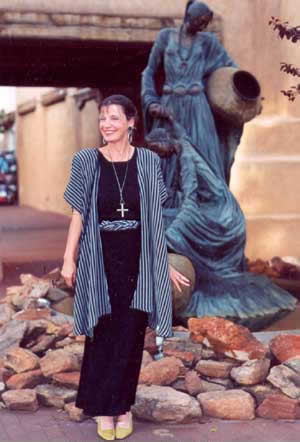The Santa Fe House
Because Santa Fe, New Mexico, is in “the high desert,” people often imagine that it’s hot and dry like neighboring Arizona. But Santa Fe is chilly–at a 7000 foot altitude, nearly a mile and a half high, up in the Rocky Mountains–we’d get four-foot deep snowfalls, even as late as mid-April!
I owned my townhouse in Santa Fe for decades. If you hiked slightly uphill from there, you were in the wilderness surrounded by baby owls and deer. If you hiked downhill a couple of blocks you were in the main Plaza of the second-oldest city, and oldest State Capital, in America. There’s every culture represented–Spanish, Anglo, Russian, French, Tibetan–and Zuni, Hopi and Navajo.
At first, I was still living in San Francisco, so I could commute there easily and ski, go to the opera, and visit the 250 art galleries and museums. (Santa Fe is the third biggest art market in America, after New York and Los Angeles.)
I remodeled the place eventually, with radiant heat, tile floors, and viga post and beam ceilings. And on the adobe wall of my kiva fireplace, I handpainted the ancient rock-wall Anasazi painted Story of the Water-Jar Boy. (My interpretation of it – see the gallery below.)
But once I’d left my treehouse behind in Sausalito, and moved across the country to Washington, DC, it was too complicated trying to get to New Mexico by air; we were always missing connections and getting stranded in Cinncinnati, Denver, or Houston. So I took to driving–a three-day trip, from door-to-door–all in total freedom!
One day, long after I’d moved back East, I got a mysterious phone call from an elderly woman in Santa Fe: “I am May Stevens, a famous artist,” she announced. “There’s a retrospective of my work, right now, under way at the National Museum of Women in the Arts, in Washington, DC.”
As it turns out, there existed a double-grant program for art historians, where they would spend six months studying at the Smithsonian American Art Museum in DC, and the rest of the year at the Georgia O’Keeffe Museum in Santa Fe. May Stevens told me that the art historian who was expert in May’s work, was doing research in DC now, but would need to rent a place in Santa Fe soon, within walking distance of the Georgia O’Keeffe.
This serendipity permitted me to rent my place out–off and on, for six months or a year apiece–to art historians, graduate students and other art experts, whom I could meet and get to know when they were doing the first part of their grant studies in DC. It was great fun, and I learned tons about the art world as it exists today. (So helpful for my book research!)

Katherine in Santa Fe (Photo: Dr. Dian Fetter)
The Water-Jar Boy
The legend of the Water-Jar Boy was painted on the rocks of the petroglyphs at La Cienega Pueblo in New Mexico. One good book about these painted stories is Petroglyphs & Pueblo Myths of the Rio Grande by Carol Patterson-Rudolph.
My painting of the story starts on the lower left, moves to the upper left, then upper right, then concludes in the lower right section of the fireplace.
In the lower left area the Ancient Ones are illustrated. Above that I have Kokopelli playing his flute. The two footprints are those of the girl who was stomping clay. Some of the clay splashed up inside of her and she gave birth to a water jar. When the water jar broke, out popped a water-jar boy. The grandfather adopted the water jar boy and taught him to hunt (upper right) and he begins to become a real boy. The water-jar boy then goes on his Quest. He crosses the great river (wavy lines) and then takes the spiral path inward (counterclockwise) to find oneself. He then travels outward (clockwise) on the journey to another realm (ending in the lower right corner).